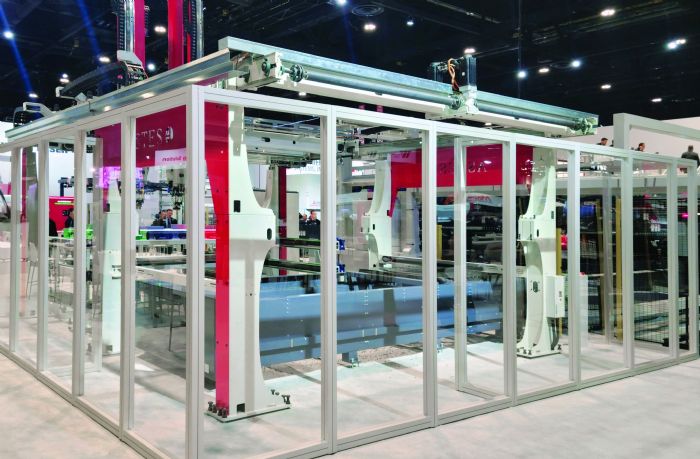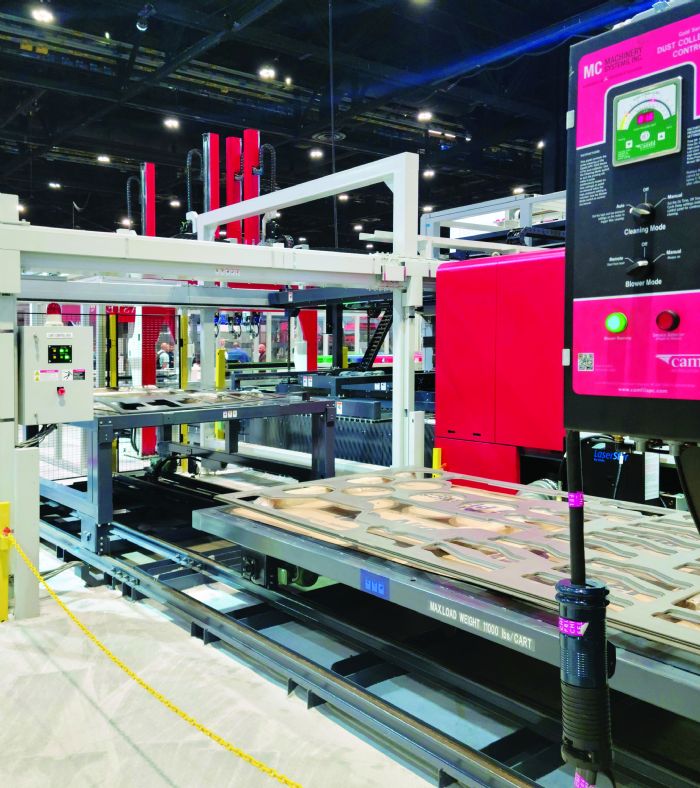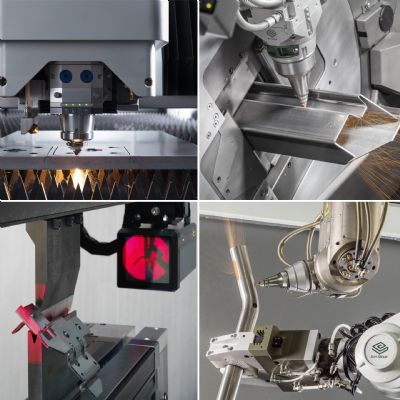“Fabricators,” Koch says, “must ask, ‘can we load and unload material and parts quickly enough?’ Just as important, they must consider how greater throughput will affect downstream processes. This is where loading and unloading automation comes in, as well as automated part sorting.”
Gains from faster cutting speeds diminish quickly when parts sit as work-in-process immediately after cutting. As laser cutting machines begin outperforming offloading operations, parts organization becomes a bottleneck. Hence the need for fabricators to think “beyond the cut,” as Koch explains.
MC Machinery, for its part, offers part-sorting automation, and demonstrated the technology via its Astes4 high-speed laser-part-sorting system at last month’s FABTECH show in Chicago, IL. The demonstration: cutting parts from ¼-in.-thick steel sheet, with a cutting cycle time of 15 min. The post-cut part-sorting automation then does its job in a 5-min. cycle time.
“Three times faster in sorting the parts than in cutting them—the situation that a fabricator wants,” Koch says.
In practice, part-sorting automation—for high speed, low-mix and for high-mix operations—sorts parts to a specific pallet or shelf at a specific destination on the shop floor. But there’s more to it.
“The parts are stacked on a pallet, ready for the press brake or painting department—wherever—in the correct order and volume to relieve the downstream-process bottleneck,” Koch explains. “I’ve seen where parts or assemblies picked by humans are brought to, say, a weld cell where the welder must start with a part that sits at the bottom of an entire part stack. With automated sorting, we ensure that the needed part sits in the right location and in the right orientation for the next process, which, again, eliminates a bottleneck and adds speed.”
Learn more about this specific automation in MetalForming’s FABTECH wrapup, coming soon to the magazine’s website.
Simplified, Effective Process Management
Software proves critical in organizing and fully benefiting from such setups.
“A job is sent to the automation,” Koch says, “ and the automation sends it to the laser cutting machine. Now the machine knows the cutting path, the automation loads the material, the cut parts go to automated sorting and they end up at downstream processes. Available software updates a manufacturer’s enterprise resource planning software throughout each of these processes and effectively manages all of it.”
Technology in such operations also enables a navigable learning curve for employees, to ensure that they can keep pace with evolving machines and automation.
“For instance, tablet-style controllers allow for simple use by anyone versed in operating a smart phone,” Koch says. “And, laser cutting machines and related automation perform tasks that previously relied on operator experience—important these days as skilled workers are in short supply. Machines see and hear the laser cutting process in real time and can adjust laser focus and feed rate, for example, and will act should a cut be lost. This artificial-intelligence-enabled capability assists greatly in lights-out operations. Fabricators can have confidence that if they walk away from equipment for a night or a weekend, technology will take appropriate action to fix problems and maintain production.”
Another technology evolution offered by Koch involves augmented reality (AR).
“AR allows virtual looks into the machine, and with overlays allows users to manipulate parts on the control screen, change their orientation, nest them, perform sheet offcuts and more. Suppose an operator runs a nest and loses a part for whatever reason—a missing tab, for instance. Using a sheet remnant from that nest job, an operator simply can drag and drop the part image onto the remnant via the control screen, and produce the part without having to tell a programmer or order a new part.” MF
See also: MC Machinery Systems
Technologies: Cutting, Pressroom Automation







 MetalForming thought that our readers would like to know more about ramifications of laser cutting power, so we tapped the expertise of Michael Koch, manager of laser and press brake applications for MC Machinery. He provides insight on this, and much more, including effective automation solutions and the role of software.
MetalForming thought that our readers would like to know more about ramifications of laser cutting power, so we tapped the expertise of Michael Koch, manager of laser and press brake applications for MC Machinery. He provides insight on this, and much more, including effective automation solutions and the role of software. In this scenario, if requirements call for oxide-free parts, (oxide film on material is a byproduct of oxygen cutting), laser power comes into play.
In this scenario, if requirements call for oxide-free parts, (oxide film on material is a byproduct of oxygen cutting), laser power comes into play.
